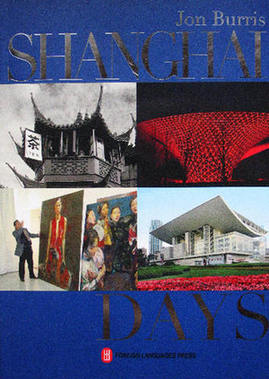Shanghai Days: A City of Contrasts
Shanghai Days: A City of Contrasts
By LIU FANGNIAN
|
 |
Shanghai Days By Jon Burris 154 pages Published in Beijing by the Foreign Languages Press in 2010 |
AS a world-famous-metropolis, Shanghai has everything – the air is thick with nostalgia and at the same time bubbling with new trends; sobering civilization and the sprightly avant-garde all have a say here. Everyone will find a face they like in Shanghai, a city instrumental in establishing the very meaning of “modern city.” What better place to explore the theme of the 2010 Expo, Better City Better Life.
On the eve of the Expo, the Foreign Languages Press extended a special invitation to Jon Burris, senior American art curator, to recreate present-day Shanghai in words and pictures. Burris has worn the hats of art consultant, curator and publisher since the 1980s, and he developed close relations with Chinese contemporary artistic circles late in that decade. The author of Shanghai Days has done a lot to promote Chinese artists in foreign countries.
Jon Burris first cooperated with Foreign Languages Press in 2008 to publish Beijing Days. He presents Beijing’s urban landscape, civil life and changes to the city over the last 20 years with taste and acuity. As Beijing Days won great attention and praise that year, Jon was invited to do Shanghai Days, with the expectation that his special angle on, and deep appreciation of, Chinese culture would create another book of quality.
Just as he says in the preface, Shanghai is a city of contrasts: contrasting nationalities, and contrasting art and architecture. The traditional culture rubs up against exotic cultures, and melts in this place. Shanghai has been able to retain all of its cultural influences without breaking its stride towards its own unique and inspiring future. This is what makes the city great.
Every city has its own story of course, and Shanghai is relatively young, but its stories are already worth savoring. From a small fishing and textile town, it became China’s first commercial port by the middle of the 19th century. Its special location – on the lip of the Yangtze River’s yawn in the middle of the continent’s long coastline and just east of China’s richest provinces – helped it rapidly develop into one of the world’s great cosmopolitan centers within a century.
As an economic, cultural and shipping center of the Far East, Shanghai became, early in the 20th century, the city with the largest population of migrants in China, and was nicknamed “Paradise of Adventurers.” At that time, the city was home to businessmen from neighboring Jiangsu and Zhejiang provinces, warlords from Northeast China, Jews from Europe, compradors from Britain, speculators from the U.S., and officials watching over concessions. People of different nationalities, cultures and walks of life rounded out the diversity of Shanghai to shape its unique character.
In this book you will see the traditional Chinese Yu Garden, while a nearby teahouse roils with Western tourists. In the antiques market, you can enjoy a shadow play and look over carved wooden furniture replicas or 1930s posters of female stars. In the former concessions, buildings of various architectural styles have become family homes, restaurants, cafés, bars or galleries. The charming streets lining the Bund house the offices of banks and corporations. The old streets, alleys and buildings, preserved and restored, are captured by Jon Burris’ lens.
If old Shanghai is the heart of the city, the arresting towers and structures that define modern Shanghai are its pulse. Shanghai’s ultramodern cityscape sports some iconic skyscrapers, invigorating the city in daytime and inviting nights of fantasy.
Jon Burris devotes the last chapter to the burgeoning avant-garde art scene. M-50 Creative Garden, Creek Art Center, and Tianzifang Art Street are artists’ habitats. The formation of an art district or two marks a prosperous and civil culture, and contributes much to Shanghai’s vitality.
Shanghai Days was published in June, just after the opening of Shanghai Expo. The media and the market have been responsive to its message.
----------------------------
LIU FANGNIAN is the editor of this book.
Services
Economy
- Eco-agriculture and Eco-tourism Power Nanchang’s Green Development
- Balance Environmental Protection and Economic Prosperity – Nanchang Looks to European Technology for Green Development
- Sustainable Growth Requires Wiser Energy Use
- Chinese Economy: On the Path of Scientific Development
- China's Economy over the Last Ten Years

